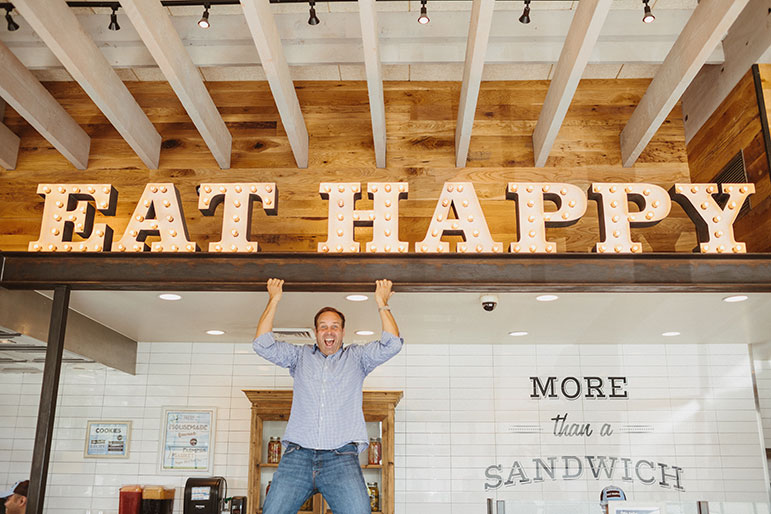Editor’s note: This is a synopsis of Food on Demand’s second webinar. To download the webinar, go to www.foodondemandnews.com/webinar.
By Laura Michaels

Mendocino Farms CEO – Mario Del Pero
If someone asked Mario Del Pero if third-party restaurant delivery is here to stay, the co-founder and CEO of the fast-casual Mendocino Farms would counter with his own question. “Is convenience a trend or a movement? Convenience is a movement,” said Del Pero with conviction. “Once people have tasted it—and now they’ve tasted it—it’s not going away.”
Del Pero, who launched Mendocino Farms with wife Ellen Chen in 2005 by opening their first location in downtown Los Angeles, was speaking to fellow operators and participants in the third-party delivery space during Food On Demand’s recent webinar, Operational Logistics: Making Room for Delivery in Your Kitchen. An online monthly publication, Food On Demand provides insights, news and information to all those innovative businesses at the intersection of food, mobility and technology.
Del Pero was speaking from experience. Mendocino Farms, which now has 16 locations in California, began its foray into delivery in spring 2016 with DoorDash. Delivery has since become “absolutely significant,” he says, so much so that he and Chen have made significant changes to their restaurants to accommodate delivery.
With delivery sales trending north of 15 percent, “we in fact had to actually change the length of our to-go counter,” Del Pero explained. “We do not have currently an online ordering system, so our third-party delivery is in fact our only online ordering system. … So we actually had to increase the counter space just to be able to handle multiple people at one time and that goes beyond having to staff it with additional people.”
Expanded waiting areas were also necessary to make room for delivery drivers carrying large, insulated bags and standing alongside customers also waiting for their orders.
In the back of the house, Mendocino Farms didn’t have to overcome the usual delivery-related packaging hurdles—“We already did almost a 40 to 45 percent to-go business prior to even adopting any third-party delivery so we’d already kind of checked the box on portability,” Del Pero said—but it did encounter other obstacles.
“I think one of the biggest things we’ve had to take on from an innovation standpoint is really how do we actually make our engine have more capacity,” said Del Pero, referring to the ability of his kitchens to increase output. Following the lead of Panera, which through ergonomic design and building vertically increased the capacity of its kitchens to accommodate in-house delivery, Mendocino installed its first “mirrored line” in its newest San Diego location. “We’ve also spent lots of money and lots of thought and effort into making our salad stations more efficient,” said Del Pero, a crucial move given about 45 percent of Mendocino’s delivery orders are for salads.
Mendocino Farms also found itself in the increasingly difficult position of wanting to protect the restaurant experience for its walk-in guests and yet still capitalize on third-party delivery. The creation of some clearly defined rules has helped, such as instructing employees to engage with the delivery drivers and encourage them to be good stewards of the Mendocino brand, and one of those rules has also given Del Pero lots to think about.
“One of our rules is if we have to tell our call-in guest that it’s a one-hour wait … we actually will turn off our third-party delivery,” he said, a decision that resulted in Mendocino turning away almost $600,000 worth of business last year. It’s also prompted Del Pero and Chen to look at delivery-only kitchens or leasing space in a larger commissary kitchen facility with other brands.

Omnivore CEO, Mike Wior
For all the physical operations changes necessitated by third-party delivery, internal technology systems can require the same tweaks, especially if a restaurant is working with multiple delivery services, each with its own tablet that requires monitoring for orders.
That’s where Omnivore comes in, said CEO Mike Wior, as its “universal API” (software speak for application programming interface) connects a restaurant’s point-of-sale system with a range of technologies, including loyalty program, reservations, payment and, of course, delivery.
This type of integration increases order accuracy and lessens wait times for delivery orders because someone isn’t having to re-enter orders from a tablet into the restaurant’s own POS, Wior explained. Plus it gives operators the flexibility to test different systems, and that flexibility, Wior said, is key to taking advantage of the new technologies that will undoubtedly arise in the coming years.


